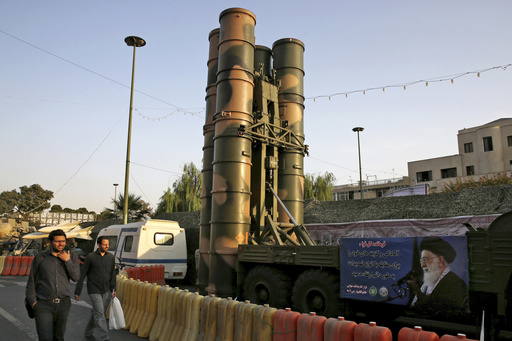JERUSALEM (AP) — Satellite photos taken Monday suggest an apparent Israeli retaliatory strike targeting Iran’s central city of Isfahan hit a radar system for a Russian-made air defense battery, contradicting repeated denials by officials in Tehran of any damage in the assault.
The strike on an S-300 radar in what appears to have been a very limited strike by the Israelis would represent far more damage done than in the massive drone-and-missile attack Iran unleashed against Israel on April 13. That may be why Iranian officials up to Supreme Leader Ayatollah Ali Khamenei have been trying to dismiss discussing what the attack actually did on Iranian soil.
Analysts believe both Iran and Israel, regional archrivals locked in a shadow war for years, now are trying to dial back tensions following a series of escalatory attacks between them as the Israel-Hamas war in the Gaza Strip still rages and inflames the wider region. But a strike on the most advanced air defense system Iran possesses and uses to protect its nuclear sites sends a message, experts say.
“This strike shows Israel has the ability to penetrate Iran’s air defense systems,” said Nicole Grajewski, a fellow at the Carnegie Endowment’s nuclear policy program who wrote a forthcoming book on Russia and Iran. “The precision of it was quite remarkable.”
The satellite images by Planet Labs PBC taken Monday morning near Isfahan’s dual-use airport and air base, some 320 kilometers (200 miles) south of Tehran, showed an area nearby that served as a deployment point for the air defense system. Burn marks sit around what analysts including Chris Biggers, a consultant former government imagery analyst, previously had identified as a “flap-lid” radar system used for the S-300.
Less-detailed satellite images taken after Friday showed similar burn marks around the area, though it wasn’t clear what was at the site. Biggers said other components of the missile system appeared to have been removed from the site — even though they provide defensive cover for Iran’s underground Natanz nuclear enrichment facility.
“That’s a powerful statement, given the system, the location, and how they use it,” Biggers wrote.
On Friday, air defenses opened fire and Iran grounded commercial flights across much of the country. Officials in the aftermath sought to downplay the attack, trying to describe it as just a series of small drones flying through the sky.
“What happened … was not a strike,” Iranian Foreign Minister Hossein Amirabdollahian claimed in an interview with NBC News. “They were more like toys that our children play with – not drones.”
In the attack’s aftermath, however, Iraqis found what appeared to be remnants of surface-to-air missiles south of Baghdad. That, coupled with a suspected Israeli strike on a radar station in Syria the same day, suggests Israeli fighter jets flew over Syria into Iraq, then fired so-called “standoff missiles” into Iran for the Isfahan attack. Small, shorter-range drones may have been launched as well — Israel has been able to launch sabotage attacks and other missions inside of Iran.
Still, Iran’s Foreign Ministry spokesman Nasser Kanaani repeated Tehran’s denial Monday.
“Relevant authorities have announced that this harassment attack has caused no damage whatsoever and Iran’s defensive system have carried out their duties,” Kanaani told journalists at a briefing. “Therefore in our opinion this issue is not worthy of addressing.”
The S-300 and their years-delayed delivery to Iran show the challenge Tehran faces in getting any foreign-made advance weapon systems into the country. Russia and Iran initially struck a $800 million deal in 2007, but Moscow suspended their delivery three years later because of strong objections from the United States and Israel.
After Iran reached its 2015 nuclear deal with world powers, Russia unfroze the deal and is believed to have given Iran four sets of an export variant of the S-300.
The relationship between Iran and Russia has deepened in recent years. Moscow relies heavily on Iran’s bomb-carrying Shahed drones to target sites across Ukraine as part of its war on the country. Those same drones featured in the Islamic Republic’s attack on Israel.
Tehran meanwhile has made repeated comments over recent years about trying to obtain Sukhoi Su-35 fighter jets from Russia to improve its decades-old fighter fleet. In September, a Russian-made YAK-130 combat trainer aircraft entered service in Iran. That model can be used to train pilots for the Su-35.
Russia now has the S-400, but the S-300 which has a range of up to 200 kilometers (125 miles) and the capability to track down and strike multiple targets simultaneously, remains one of the most-potent air defense weapons in the world. The batteries can be used to shoot down missiles as well as aircraft.
Iran likely needs Russian assistance to repair the damaged radar — and will seek newer weapons as well as time goes on, Grajewski said.
“Iran wants new weapons from Russia all the time – to try to show that it’s not so isolated,” she said.



